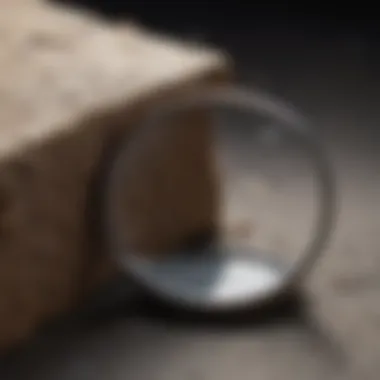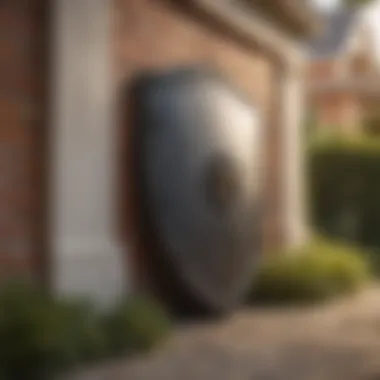Securing Your Home: Expert Strategies to Keep Pests Out


DIY Pest Control Techniques
For homeowners looking to tackle pest issues on their own, implementing do-it-yourself pest control techniques can be a cost-effective and environmentally friendly approach. Homemade pest control solutions utilizing common household ingredients, such as vinegar, baking soda, or citrus oils, can help deter pests and maintain a pest-free environment.
Using essential oils for pest control is another natural alternative to chemical sprays, with oils like eucalyptus, citronella, and tea tree offering effective repellent properties against pests. Creating DIY pest traps and barriers, such as sticky traps or physical barriers, can help capture and exclude pests from your home.
Exploring reputable pest control brands that offer safe and reliable products for home pest management, such as traps, baits, or repellents, can provide homeowners with additional tools for addressing pest infestations. By selecting products from trusted brands, you can safeguard your home against pests effectively.
Incorporating miscellaneous DIY pest control techniques, such as using diatomaceous earth for crawling insects, installing door sweeps to prevent rodent entry, or sealing cracks with caulk to exclude pests, can offer targeted solutions for specific pest problems. By combining various DIY approaches, homeowners can tailor their pest control efforts to meet their unique needs and preferences.
Understanding Pest Entry Points
Exterior Vulnerabilities
Gaps around Doors and Windows
Gaps around doors and windows present a common entry point for pests seeking shelter and food within residential structures. These openings, often overlooked, provide easy access for insects and rodents to infiltrate homes. Proper insulation and sealing of these gaps are essential to prevent infestations. While small in size, these openings can lead to significant pest problems if left unattended.
Cracks in Foundation
Cracks in the foundation of a house serve as another susceptibility for pest entry. These structural weaknesses not only compromise the integrity of the building but also offer an invitation to pests. Addressing foundation cracks promptly is vital in pest prevention, as it eliminates a direct path for insects and small animals to enter the home undetected.
Vents and Chimneys
Vents and chimneys, designed to provide ventilation, are often equipped with openings large enough to accommodate pest entry. Birds, squirrels, and insects may find their way into these spaces, creating potential infestation risks. Properly securing and maintaining these areas is crucial to mitigating pest intrusion and maintaining a pest-free environment.
Interior Weaknesses


Gaps in Walls and Floors
Internally, gaps in walls and floors can also serve as entry points for pests. Small insects and rodents can exploit these imperfections to gain access to different areas of the house. Close attention to these gaps, along with effective sealing methods, is essential in preventing pest infestations and maintaining a secure indoor environment.
Attic and Basement Openings
Attics and basements often harbor unnoticed openings that allow pests to enter and establish nests. These enclosed spaces provide ideal conditions for pests to thrive if not adequately secured. Regular inspection and reinforcement of these areas are imperative to prevent infestations that could compromise the structural integrity of the house.
Utility Penetrations
Utility penetrations, such as pipes and cables entering the house, can create gaps that serve as pathways for pests. The spaces around these utilities must be properly sealed to thwart potential intrusions. Failure to address these penetrations can result in pest infestations and potential damage to the home's infrastructure. Maintaining vigilance over these points of entry is crucial for effective pest control and household protection.
Sealing Strategies for Pest Prevention
Sealing strategies play a pivotal role in safeguarding your house from pest infestation. By understanding the significance of sealing options, you can effectively ward off unwanted intruders. Not only does sealing prevent pests from entering your home, but it also enhances the overall structural integrity of your house. When considering pest prevention, prioritizing sealing strategies ensures a long-term solution to potential infestation.
Exterior Sealants
When it comes to exterior sealants, focusing on weatherstripping doors and windows is crucial. Weatherstripping helps create a tight seal, preventing pests from sneaking through gaps. The key characteristic of weatherstripping is its ability to block out insects and rodents efficiently. This choice is highly beneficial for this article as it addresses a common entry point for pests. However, one downside is that weatherstripping may require regular maintenance to uphold its effectiveness.
Applying caulk to gaps is another essential aspect of sealing exterior vulnerabilities. Caulk serves as a protective barrier against pests by sealing off any openings that could serve as access points. The unique feature of using caulk lies in its adaptability to various surfaces and its long-lasting durability. Incorporating caulk into your sealing strategy provides a reliable defense mechanism against pest intrusion. Yet, a disadvantage of using caulk is the need for precision during application to ensure comprehensive coverage.
Repairing damaged vents is equally significant in fortifying your home against pests. Vents can often serve as easy entry points for insects and small animals if not adequately maintained. By repairing damaged vents, you eliminate potential openings that pests could exploit. The distinct advantage of this method is the immediate reduction of entry points for pests, contributing to a more secure household environment. Nonetheless, the challenge lies in identifying and addressing all vent damages effectively to prevent any gaps from remaining.
Interior Insulation
Turning to interior insulation, using steel wool is a practical approach to pest prevention. Steel wool acts as a barrier against rodents and other pests that can chew through conventional materials. The key characteristic of steel wool is its resilience and ability to withstand pest-induced damage. This choice is popular for its effectiveness in deterring pests from accessing certain areas within your home. However, a drawback is that steel wool may corrode over time and require periodic replacement to uphold its protective properties.
Sealing wall cracks is another crucial step in ensuring a pest-free interior. Cracks in walls can serve as hidden pathways for pests to navigate through your house. By sealing these cracks, you create a seamless barrier that hinders pest movement. The unique feature of sealing wall cracks is its ability to address hidden vulnerabilities that pests could exploit. This method offers a proactive approach to pest control within your living spaces. Nevertheless, the challenge lies in identifying all wall cracks, especially in hard-to-reach areas, to effectively seal off any potential entries.


Installing door sweeps completes the comprehensive interior insulation strategy. Door sweeps help to block off gaps at the bottom of doors, thereby preventing pests from entering living spaces. The key characteristic of door sweeps is their easy installation and effectiveness in sealing off door gaps. This choice is a beneficial addition to this article as it addresses a commonly overlooked entry point for pests. However, a disadvantage of door sweeps is the need for occasional adjustments to maintain a tight seal and prevent wear and tear.
Maintenance and Hygiene Practices
In the realm of safeguarding your house against pest infestation, upholding maintenance and hygiene practices holds paramount significance. Maintaining a clean and organized living space not only enhances the overall aesthetic appeal but also plays a pivotal role in deterring pests from infiltrating your home. By paying diligent attention to upkeep and hygiene, individuals can thwart potential pest infestations before they escalate, thus fostering a healthier and more pleasant living environment.
Proper Waste Disposal
Secure Trash Bins:
Secure trash bins embody a crucial component of effective waste management systems, significantly contributing to the prevention of pest infestation. Their robust construction and tightly sealed lids act as formidable barriers against rodents and insects seeking refuge in discarded waste. The key characteristic of secure trash bins lies in their ability to contain odors and prevent easy access to garbage contents, dissuading pests from foraging for sustenance. This feature renders secure trash bins a popular choice for households aiming to maintain cleanliness and hygiene, reducing the allure of their premises to potential pests. While secure trash bins offer unparalleled protection against pest infiltration, prudent consideration should be given to their size and placement to optimize their efficacy within the context of this article.
Regular Garbage Disposal:
Regular garbage disposal is integral to upholding a hygienic living environment and mitigating pest infestation risks. By promptly removing accumulated garbage, individuals disrupt the primary food source for pests, discouraging their presence in and around the property. The fundamental characteristic of regular garbage disposal is its role in minimizing clutter and eliminating potential harborage sites for pests within the vicinity. Embracing a routine for garbage disposal not only cultivates cleanliness but also hampers the breeding and foraging activities of pests, safeguarding your home against infestations. While regular garbage disposal offers undeniable benefits in pest prevention, individuals should remain attuned to environmental considerations and waste management regulations for a well-rounded approach within the scope of this article.
Cleanliness Measures
Instituting meticulous cleanliness measures within your living space constitutes a pivotal aspect of pest prevention and overall house maintenance. Striving for clutter-free and well-organized surroundings not only elevates the visual appeal of your home but also addresses underlying factors that attract pests. By prioritizing cleanliness, individuals create an unwelcoming environment for pests, thwarting their attempts to establish residency and ensuring a pest-free living space.
Decluttering Spaces:
Decluttering spaces within your home plays a pivotal role in minimizing hiding spots for pests and disrupting their potential nesting grounds. The key characteristic of decluttering spaces lies in enhancing accessibility for inspections and cleaning, thereby eliminating covert areas where pests can thrive unnoticed. Opting for a clutter-free environment not only enhances the aesthetic appeal of your household but also simplifies pest detection and management processes, fostering a proactive approach towards pest prevention. The unique feature of decluttering spaces lies in its ability to reduce stress and improve overall well-being, creating a harmonious living environment that dissuades pests from encroaching upon your premises. While decluttering spaces yield numerous advantages in pest mitigation, individuals should remain cognizant of personalized organizational strategies to optimize space utilization effectively within the context of this article.
Regular Cleaning Routine:
Enforcing a regular cleaning routine within your home serves as a cornerstone in pest prevention and maintenance practices. Consistent cleaning not only ensures a fresh and hygienic living environment but also eradicates debris and food residues that attract pests. The primary characteristic of a regular cleaning routine is its ability to eliminate potential food sources and breeding grounds for pests, curtailing their population growth and reducing the risk of infestation. Embracing a structured cleaning regimen fosters discipline and orderliness, promoting proactive pest management and minimizing the likelihood of unwelcome intruders in your home. The unique feature of a regular cleaning routine lies in its capacity to preserve indoor air quality and uphold sanitation standards, cultivating a healthy habitat that deters pests effectively. While adhering to a regular cleaning routine provides multifold benefits in pest control, individuals should tailor their cleaning schedules to align with specific needs and lifestyle considerations for optimal efficacy within the framework of this article.


Professional Pest Control Services
Professional pest control services play a pivotal role in safeguarding your home from unwanted invaders. These services are essential for maintaining a pest-free environment, ensuring the safety and well-being of your household. By entrusting the expertise of pest control professionals, you are taking a proactive approach to pest management that can save you time, money, and potential damage to your property.
Consulting Pest Experts
When it comes to consulting pest experts, one crucial aspect is the thoroughness of their inspection services. Inspection services involve in-depth examinations of your property to identify existing pest issues and potential vulnerabilities. This meticulous process allows the specialists to devise tailored treatment plans suited to your specific needs, effectively addressing any pest infestations while preventing future problems.
Inspection Services
Inspection services are distinguished by their detailed and comprehensive nature. Pest experts meticulously scrutinize every nook and cranny of your home, searching for signs of infestation and areas of concern. This methodical approach ensures that no pest-related issue goes unnoticed, enabling the specialists to formulate targeted solutions that prioritize effectiveness and long-term prevention.
Another key characteristic of inspection services is their ability to detect early warning signs of pest infestation. By catching problems in their early stages, pest professionals can implement strategic measures to eradicate pests before they escalate. This proactive stance not only minimizes the impact of infestations but also prevents extensive damage that can result from untreated pest issues.
Treatment Plans
Treatment plans are the strategic roadmaps developed by pest control experts to address identified pest problems effectively. These plans outline the specific steps and techniques required to eradicate pests from your property, tailored to the type and extent of infestation present. By customizing treatment plans to suit your unique circumstances, pest professionals ensure maximum efficacy in pest removal while prioritizing the safety of your household.
A notable feature of treatment plans is their emphasis on sustainable pest management practices. Pest control experts utilize eco-friendly solutions and humane treatment methods to minimize environmental impact and protect the health of your family and pets. This conscientious approach sets treatment plans apart, promoting a harmonious balance between pest eradication and environmental responsibility.
Regular Monitoring and Maintenance
In addition to initial treatments, regular monitoring and maintenance are fundamental aspects of professional pest control services. Scheduled visits from pest experts enable ongoing assessment of your property's pest status, allowing for timely interventions and preventative measures to be implemented as needed.
Scheduled Visits
Scheduled visits form the cornerstone of proactive pest management. During these routine appointments, pest professionals conduct thorough inspections to evaluate the effectiveness of previous treatments and assess any new pest threats. By staying ahead of potential issues through regular monitoring, pest experts can make necessary adjustments to treatment plans, ensuring continued protection for your home.
One key advantage of scheduled visits is their proactive nature. By preemptively addressing emerging pest concerns, pest control specialists can nip problems in the bud, preventing minor issues from spiraling into full-blown infestations. This proactive stance not only enhances the effectiveness of pest control measures but also safeguards your property from significant damage and inconvenience.
Preventive Treatments
Complementing scheduled visits are preventive treatments aimed at fortifying your home against future pest incursions. These preventive measures involve the application of barriers, repellents, and other proactive solutions to deter pests from entering your property. By fortifying vulnerable areas and creating a hostile environment for pests, preventive treatments serve as a frontline defense in pest control.
One distinctive feature of preventive treatments is their long-term benefits. By investing in preemptive pest management strategies, homeowners can enjoy prolonged protection against a variety of pests, minimizing the likelihood of infestations and the need for extensive remedial action. This proactive approach not only promotes peace of mind but also preserves the integrity and value of your home over time.



